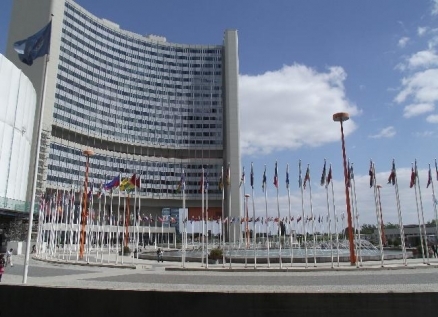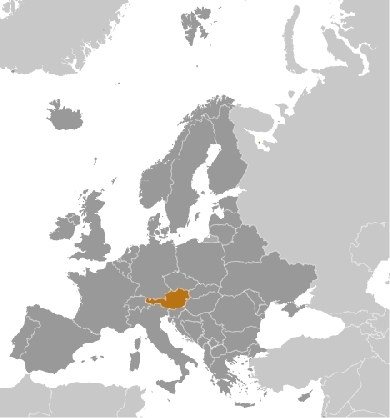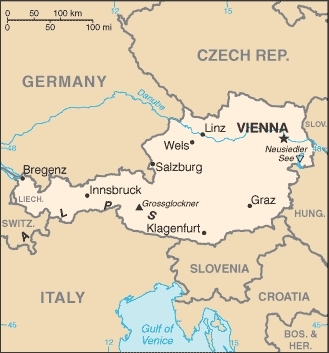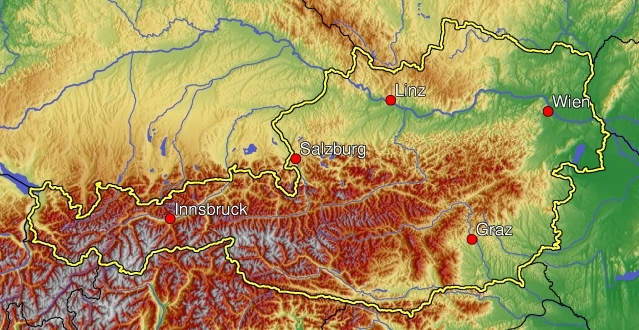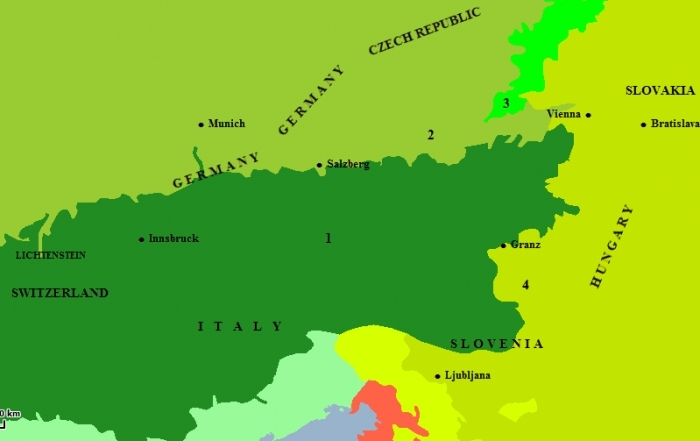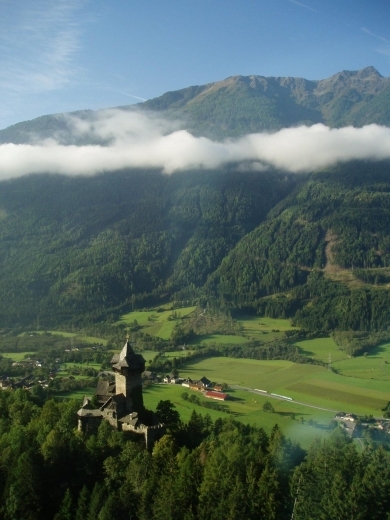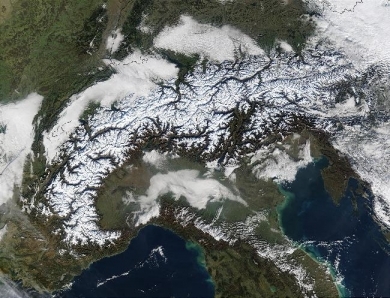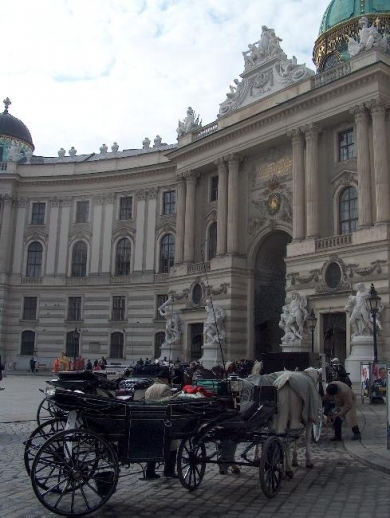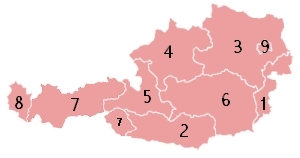Austria
Countries and Regions of the World Collection  Austria is a nation of over 8 million people in central Europe, north of Italy and Slovenia and south of Germany and the Czech Republic. To the west Austria borders Switzerland and in the east, Hungary and Slovakia.
Austria is a nation of over 8 million people in central Europe, north of Italy and Slovenia and south of Germany and the Czech Republic. To the west Austria borders Switzerland and in the east, Hungary and Slovakia.
Landlocked, Austria has a strategic location at the crossroads of central Europe with many easily traversable Alpine passes and valleys. Its major river is the Danube.
Austria's population is concentrated on eastern lowlands because of steep slopes, poor soils, and low temperatures elsewhere.
Its major environmental issues include: some forest degradation caused by air and soil pollution; soil pollution results from the use of agricultural chemicals; air pollution results from emissions by coal- and oil-fired power stations and industrial plantsp; and, from trucks transiting Austria between northern and southern Europe. Austria is susceptible to landslides; avalanches; and earthquakes.
Once the center of power for the large Austro-Hungarian Empire, Austria was reduced to a small republic after its defeat in World War I.
Following annexation by Nazi Germany in 1938 and subsequent occupation by the victorious Allies in 1945, Austria's status remained unclear for a decade. A State Treaty signed in 1955 ended the occupation, recognized Austria's independence, and forbade unification with Germany. A constitutional law that same year declared the country's "perpetual neutrality" as a condition for Soviet military withdrawal.
The Soviet Union's collapse in 1991 and Austria's entry into the European Union (EU) in 1995 have altered the meaning of this neutrality. A prosperous, democratic country, Austria entered the EU Economic and Monetary Union in 1999.
Contents
Geography
Location: Central Europe, north of Italy and Slovenia
Geographic Coordinates: 47 20 N, 13 20 E
Area: 83,871 sq km (land 82,445 sq km; water 1,426 sq km)
Land Boundaries: 2,562 km (Czech Republic 362 km, Germany 784 km, Hungary 366 km, Italy 430 km, Liechtenstein 35 km, Slovakia 91 km, Slovenia 330 km, Switzerland 164 km)
Natural Hazards: landslides; avalanches; earthquakes
Terrain: In the west and south mostly mountains (Alps); along the eastern and northern margins mostly flat or gently sloping. The highest point is Grossglockner (3,798 m) and the lowest point is Neusiedler See (115 m).
Climate: Temperate; continental, cloudy; cold winters with frequent rain and some snow in lowlands and snow in mountains; moderate summers with occasional showers
Topgraphy of Austria. Source: Wikimedia Commons
Ecology and Biodiversity
Ecoregions of Austria. Source: World Wildlife Fund
See:
- Alps conifer and mixed forests (dark green) covers most of the country including the west and much of the central Alpine regions.
- Western European Broadleaf forests (green) cover the north of the country except in the west.
- Central European mixed forestsoccupy a strip of land entending down from the Czech Republic into the north of Austria.
- Pannonian mixed forests cover the western plains
| A castle and mountain valley in the Alps. |
| The Alps march across this image of Autumnal (early October) southern Europe. On either side of and above the Alps are the countries of (from left to right) France, Switzerland, Liechtenstein, Austria, and Slovenia, while below the Alps is Italy. The Mediterranean and Ligurian Seas sit to the west of Italy, while to the right is the Adriatic Sea. As the season progresses, snow begins to whiten the Alps. Image courtesy of NASA. |
| Horse-drawn coaches (known as fiaker in Vienna) await riders in front of the grand Michaelertrakt (Michael's Wing) of the Hofburg (Imperial Palace). |
People and Society
Austrians are relatively homogeneous; about 90% speak German as their everyday language. However, there has been a significant amount of immigration, particularly from former Yugoslavia and Turkey, over the past 2 decades. Only two numerically significant indigenous minority groups exist--18,000 Slovenes in Carinthia (south central Austria) and 19,400 Croats in Burgenland (on the Hungarian border). Slovene and Croat minority rights are protected under Austria’s 1955 State Treaty and in related national law. According to 2011 estimates by the Vienna Institute of Demography, 68% of Austrians identify themselves as Roman Catholic. The church abstains from political activity. Immigration has increased the proportion of Muslims and Orthodox in Austria. Small Lutheran minorities are located mainly in Vienna, Carinthia, and Burgenland. There are some Islamic communities, concentrated in Vienna and Vorarlberg.
Population: 8,219,743 (July 2012 est.)
Ethnic groups: Austrians 91.1%, former Yugoslavs 4% (includes Croatians, Slovenes, Serbs, and Bosniaks), Turks 1.6%, German 0.9%, other or unspecified 2.4% (2001 census)
Age Structure:
0-14 years: 14% (male 590,855/female 563,300)
15-64 years: 67.7% (male 2,793,725/female 2,769,840)
65 years and over: 18.2% (male 627,456/female 872,104) (2011 est.)
Population Growth Rate: 0.026% (2012 est.)
Birthrate: 8.69 births/1,000 population (2012 est.)
Death Rate: 10.23 deaths/1,000 population (July 2012 est.)
Net Migration Rate: 1.79 migrant(s)/1,000 population (2012 est.)
Life Expectancy at Birth: 79.91 years
male: 77 years
female: 82.97 years (2012 est.)
Total Fertility Rate: 1.41 children born/woman (2012 est.)
Languages: German (official nationwide) 88.6%, Turkish 2.3%, Serbian 2.2%, Croatian (official in Burgenland) 1.6%, other (includes Slovene, official in Carinthia, and Hungarian, official in Burgenland) 5.3% (2001 census)
Literacy (age 15 and over can read and write): 98%
Urbanization: 68% of total population (2010) growing at an annual rate of change of 0.6% (2010-15 est.)
History
Austrian history dates back to 976, when Leopold von Babenberg became the ruler of much of present-day Austria. In 1276 Rudolf I became the first Habsburg to ascend to the throne.
The Habsburg Empire
Although never unchallenged, the Habsburgs ruled Austria for nearly 750 years. Through political marriages, the Habsburgs were able to accumulate vast land wealth encompassing most of central Europe and stretching even as far as the Iberian Peninsula. After repulsing challenges from the Ottoman Empire in the 16th and 17th centuries, Austrian territory became increasingly consolidated in the central European part of the Danube basin.
In 1848 Franz Josef I ascended to the throne and remained in power until his death in 1916. Franz Josef saw many milestones in Austrian history. The Compromise of 1867 gave greater political rights to Hungary within the Empire, creating what became known as the Dual Monarchy. Political unity deteriorated further in the beginning of the 20th century, culminating, under the stress of World War I, in the collapse of the Empire and proclamation of an Austrian Republic on territory roughly identical to modern-day Austria. In 1919, the Treaty of St. Germain officially ended Habsburg rule and established the Republic of Austria.
Political Turmoil During the Inter-War Years 'and the' Anschluss
From 1918 to 1934, Austria experienced sharpening political strife. In the late 1920s and early 1930s, paramilitary political organizations were engaged in strikes and violent conflicts. Unemployment rose to an estimated 25%. In 1934, a corporatist and authoritarian government came into power in Austria. Austrian National Socialists (NS) launched an unsuccessful coup d'etat in July 1934. In February 1938, under threats of military intervention from Germany, Chancellor Kurt Schuschnigg was forced to accept Austrian National Socialists (Nazis) in his government. On March 12, Germany sent military forces into Austria and annexed the country ("Anschluss"), an action that received enthusiastic support from many Austrians.
The Holocaust in Austria
From March 1938 to April 1945, most of the Jewish population of the country was murdered or forced into exile. Other minorities, including the Sinti and Roma, homosexuals, and many political opponents of the Nazis also received similar treatment. Prior to 1938, Austria's Jewish population constituted 200,000 persons, or about 3% to 4% of the total population. Most Jews lived in Vienna, where they comprised about 9% of the population. Following Anschluss, Jews were forced out of many professions and lost access to their assets. In November 1938, the Nazis launched the Kristallnacht pogrom in Austria as well as in Germany. Jewish businesses were vandalized and ransacked. Thousands of Jews were arrested and deported to concentration camps. Jewish emigration increased dramatically. Between 1938 and 1940, over half of Austria's Jewish population fled the country. Some 35,000 Jews were deported to the Ghettos in eastern Europe. Some 67,000 Austrian Jews (or one-third of the total 200,000 Jews residing in Austria) were sent to concentration camps. Those in such camps were murdered or forced into dangerous or severe hard labor that accelerated their death. Only 2,000 of those in the death camps survived until the end of the war.
Austria Post-World War II
After April 1945, the victorious allies divided Austria into zones of occupation similar to those in Germany with a four-power administration of Vienna. Under the 1945 Potsdam agreements, the Soviets took control of German assets in their zone of occupation. These included 7% of Austria's manufacturing plants, 95% of its oil resources, and about 80% of its refinery capacity. The properties were returned to Austria under the Austrian State Treaty. This treaty, signed in Vienna on May 15, 1955, came into effect on July 27. Under its provisions, all occupation forces departed by October 25, 1955. Austria became free and independent for the first time since 1938.
Austrian Compensation Programs and Acknowledgement of its Nazi Role
During the immediate postwar period, Austrian authorities introduced certain restitution and compensation measures for Nazi victims, but many of these initial measures were later seen as inadequate and/or unjust. There is no official estimate of the amount of compensation made under these programs. More disturbing for many was the continuation of the view that prevailed since 1943 that Austria was the "first free country to fall victim" to Nazi aggression. This "first victim" view had been fostered by the Allied Powers in the Moscow Declaration of 1943, in which the Allies declared as null and void the Anschluss and called for the restoration of the country's independence. The Allied Powers did not ignore Austria's responsibility for the war, but nothing was said explicitly about Austria's responsibility for Nazi crimes on its territory. The controversial debate about the long-hidden wartime past of former UN Secretary General Kurt Waldheim, who was elected Austrian President in 1986, painfully forced Austrians to confront the country’s role before and during World War II. With the collapse of the Soviet Union in 1991, greater attention was given in many countries, including Austria, to unresolved issues from World War II. On November 15, 1994, Austrian President Thomas Klestil addressed the Israeli Knesset, noting that Austrian leaders "... spoke far too rarely of the fact that some of the worst henchmen of the NS dictatorship were in fact Austrians. .... In the name of the Republic of Austria, I bow my head before the victims of that time." Since 1994, Austria has committed to providing victims and heirs some $1 billion in restitution. Payments are made through the National Fund for Victims of National Socialism (established in 1995), which provides lump-sum payments to victims of Nazi persecution and their heirs, and the General Settlement Fund (established in 2001), which addresses gaps and deficiencies in postwar restitution programs. The Reconciliation Fund (established in 2000 and disbanded in 2005) provided one-time payments to Nazi-era forced and slave laborers. Its successor organization, the Future Fund (established 2006) supports projects with an emphasis on Holocaust and tolerance education.
Government
The Austrian president convenes and concludes parliamentary sessions and under certain conditions can dissolve Parliament. However, no Austrian president has dissolved Parliament in the Second Republic. The custom is for Parliament to call for new elections, if needed. The president requests a party leader, usually the leader of the strongest party, to form a government. Upon the recommendation of the Federal Chancellor, the president also appoints cabinet ministers.
The Federal Assembly (Parliament) consists of two houses--the National Council (Nationalrat), or lower house, and the Federal Council (Bundesrat), or upper house. Legislative authority resides in the National Council. Its 183 members serve for a maximum term of 5 years in a three-tiered system, on the basis of proportional representation. The National Council may dissolve itself by a simple majority vote or the president may dissolve it on the recommendation of the Chancellor. The nine state legislatures elect the 62 members of the Federal Council for 5- to 6-year terms. The Federal Council only reviews legislation passed by the National Council and can delay but not veto its enactment.
The legislatures of Austria's nine Bundeslaender (states) elect the governors. Although most authority, including that of the police, rests with the federal government, the states have considerable responsibility for welfare matters and local administration. Strong state and local loyalties have roots in tradition and history.
Government Type: Federal republic
Capital: Vienna (population: 1.693 million - 2009)
|
Administrative Divisions: 9 states (Bundeslaender, singular - Bundesland);
|
Source: Wikimedia Commons |
Independence: 12 November 1918 (republic proclaimed)
Notable earlier dates:
- 976 (Margravate of Austria established);
- 17 September 1156 (Duchy of Austria founded);
- 11 August 1804 (Austrian Empire proclaimed).
Austria's National Day is 26 October (1955); which commemorates the passage of the law on permanent neutrality.
Legal System: civil law system; judicial review of legislative acts by the Constitutional Court. Austria accepts compulsory International Court of Justice (ICJ) jurisdiction and accepts International Criminal Court (ICCt) jurisdiction. The highest courts of Austria's independent judiciary are the Constitutional Court; the Administrative Court, which handles bureaucratic disputes; and the Supreme Court, for civil and criminal cases. While the Supreme Court is the court of highest instance for the judiciary, the Administrative Court acts as the supervisory body over government administrative acts of the executive branch, and the Constitutional Court presides over constitutional issues. The Federal President appoints the justices of the three courts for specific terms.
International Environmental Agreements
Austria is party to international agreements on Air Pollution, Air Pollution-Nitrogen Oxides, Air Pollution-Persistent Organic Pollutants, Air Pollution-Sulfur 85, Air Pollution-Sulphur 94, Air Pollution-Volatile Organic Compounds, Antarctic Treaty, Biodiversity, Climate Change, Climate Change-Kyoto Protocol, Desertification, Endangered Species, Environmental Modification, Hazardous Wastes, Law of the Sea, Ozone Layer Protection, Ship Pollution, Tropical Timber 83, Tropical Timber 94, Wetlands, and Whaling.
Water
Total Renewable Water Resources: 84 cu km (2005)
Freshwater Withdrawal: 3.67 cu km/yr (35% domestic, 64% industrial, 1% agricultural) - per capita: 448 cu m/yr (1999)
Agriculture
Austrian farms, like those of other west European mountainous countries, are small and fragmented, and production is relatively expensive. Since Austria joined the EU in 1995, the Austrian agricultural sector has been undergoing substantial reform under the EU's common agricultural policy (CAP). Although Austrian farmers provide about 85% of domestic food requirements, the contribution of agriculture, forestry, and fisheries to gross domestic product (GDP) has consistently declined over the last decades to just 1.5% (2010).
Agricultural products: grains, potatoes, wine, fruit; dairy products, cattle, pigs, poultry; lumber
Irrigated Land: 1,170 sq km (2008)
Resources
Natural Resources: oil, coal, lignite, timber, iron ore, copper, zinc, antimony, magnesite, tungsten, graphite, salt, hydropower
Land Use:
arable land: 16.59%
permanent crops: 0.85%
other: 82.56% (2005)
Economy
Austria, with its well-developed market economy and high standard of living, is closely tied to other European Union (EU) economies, especially Germany's.
Its economy features a large service sector, a sound industrial sector, and a small, but highly developed agricultural sector.
Following several years of solid foreign demand for Austrian exports and record employment growth, the international financial crisis and global economic downturn in 2008 led to a sharp but brief recession. Austrian GDP contracted 3.9% in 2009 but saw positive growth of about 2% in 2010.
Unemployment did not rise as steeply in Austria as elsewhere in Europe, partly because the government subsidized reduced working hour schemes to allow companies to retain employees. Stabilization measures, stimulus spending, and an income tax reform pushed the budget deficit to 4.7% in 2010 and 3.6% in 2011, from only about 1.3% in 2008. The international financial crisis of 2008 caused difficulties for Austria's largest banks whose extensive operations in central, eastern, and southeastern Europe faced large losses. The government provided bank support - including in some instances, nationalization - to support aggregate demand and stabilize the banking system.
Austria's fiscal position compares favorably with other euro-zone countries, but it faces considerable external risks, such as Austrian banks' continued high exposure to central and eastern Europe as well as political and economic uncertainties caused by the European sovereign debt crisis. The government's efforts in 2011 to pass a constitutional amendment limiting public debt to 60% of GDP by 2020 faced resistance from opposition parties in parliament
Austria’s economy benefited greatly from its entry into the EU in 1995, the introduction of the Euro in 2002, and its growing commercial relations--especially in the banking and insurance sectors--in central, eastern, and southeastern Europe. However, this interdependency has made Austria vulnerable to financial instability in the region. Some of Austria's largest banks have required government support--including in two instances, nationalization--to avoid potential insolvency and wider regional contagion. The Austrian Financial Market Authority (FMA) and the Austrian National Bank (OeNB) have recently devised a set of measures, such as moving up implementation of the Basel III rules, to strengthen banking groups’ capital adequacy and to make more sustainable the business models used by Austrian banks operating in central, eastern, and southeastern Europe. Austria will also need to continue restructuring, emphasizing knowledge-based sectors of the economy while encouraging greater labor flexibility and greater labor participation to offset such problems as structural unemployment, an aging population, and a low fertility rate.
Austria has a strong but slightly shrinking labor movement. The Austrian Trade Union Federation (OGB) comprises constituent unions with a total membership of about 1.2 million--about 35% of the country's wage and salary earners. The OGB has always pursued a moderate, consensus-oriented wage policy, cooperating with industry, agriculture, and the government on a broad range of social and economic issues in what is known as Austria's "social partnership." With further budget cuts and unpopular reforms on the horizon, the debate over income distribution is likely to become more pronounced, as shown by warning strikes during 2011’s collective bargaining rounds.
Trade with other EU-27 countries accounts for almost 72% of Austrian imports and exports (2010). Expanding trade and investment in the new EU members of central and eastern Europe represent a major pillar of Austrian economic policy. Austrian firms have sizable investments there and continue to move labor-intensive, low-tech production to these countries. About one-half of Austria's foreign direct investment (FDI) is concentrated in the countries of central, eastern, and southeastern Europe. Many western European and international companies have located their central/eastern European headquarters in Austria.
GDP: (Purchasing Power Parity): $351.4 billion (2011 est.)
GDP: (Official Exchange Rate): $425.1 billion (2011 est.)
GDP- per capita (PPP): $41,700 (2011 est.)
GDP- composition by sector:
agriculture: 1.5%
industry: 29.5%
services: 69% (2011 est.)
Industries: construction, machinery, vehicles and parts, food, metals, chemicals, lumber and wood processing, paper and paperboard, communications equipment, tourism
Currency: Euros (EUR)
